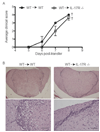IL-23 modulated myelin-specific T cells induce EAE via an IFNγ driven, IL-17 independent pathway
- PMID: 20951792
- PMCID: PMC3064959
- DOI: 10.1016/j.bbi.2010.10.001
IL-23 modulated myelin-specific T cells induce EAE via an IFNγ driven, IL-17 independent pathway
Abstract
Experimental autoimmune encephalomyelitis (EAE) is an inflammatory demyelinating disease of the central nervous system (CNS) mediated by myelin-reactive CD4(+) T cells. An unresolved issue that has important clinical implications concerns the cytokines produced by myelin-reactive T cells that determine their pathogenicity. Initially, IL-12 polarized, IFNγ producing Th1 cells were thought to be essential for the development of EAE. More recently, IL-23 polarized, IL-17 producing Th17 cells have been highlighted as critical encephalitogenic effectors. There is growing evidence that parallel autoimmune pathways can result in common clinical and histopathological endpoints. In the current study, we describe a form of EAE induced by the transfer of IL-23 modulated CD4(+) T cells into IL-17 receptor (IL-17R) deficient hosts. We found that IL-23 stimulates myelin-reactive T cells to produce both IFNγ and IL-17. Surprisingly, in this model the development of EAE is IFNγ dependent. Our findings illustrate a novel mechanism by which IL-23 promotes encephalitogenicity and they further expand the spectrum of autoreactive T cells capable of mediating inflammatory demyelinating disease of the CNS.
Copyright © 2010 Elsevier Inc. All rights reserved.
Figures




References
-
- Beller DI. Functional significance of the regulation of macrophage Ia expression. Eur J Immunol. 1984;14:138–143. - PubMed
-
- Billiau A, Heremans H, Vandekerckhove F, Dijkmans R, Sobis H, Meulepas E, Carton H. Enhancement of experimental allergic encephalomyelitis in mice by antibodies against IFN-gamma. J Immunol. 1988;140:1506–1510. - PubMed
Publication types
MeSH terms
Substances
Grants and funding
LinkOut - more resources
Full Text Sources
Research Materials

